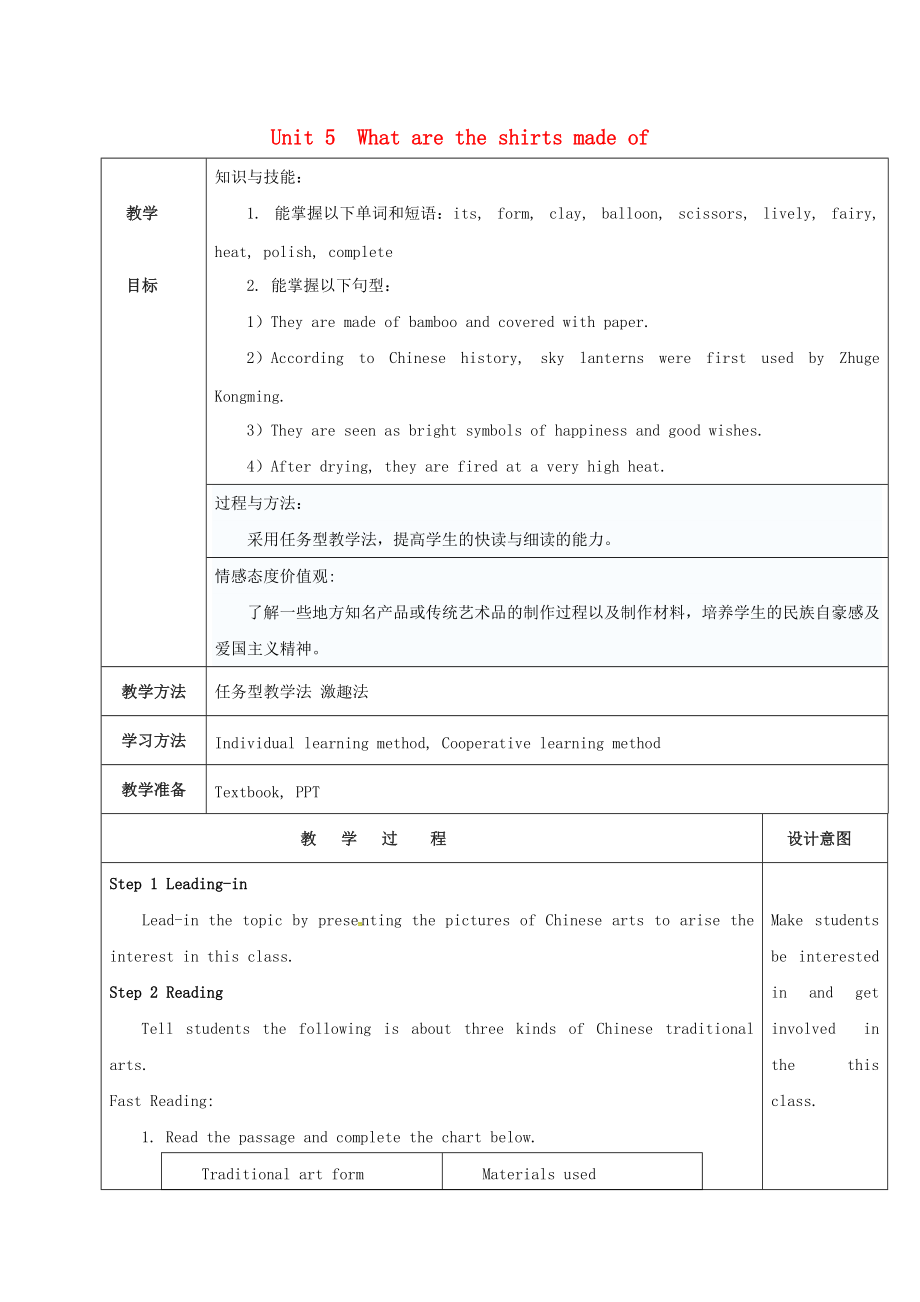《九年級(jí)英語全冊(cè) Unit 5 What are the shirts made of Section B 2a2e教案 新版人教新目標(biāo)版》由會(huì)員分享�����,可在線閱讀���,更多相關(guān)《九年級(jí)英語全冊(cè) Unit 5 What are the shirts made of Section B 2a2e教案 新版人教新目標(biāo)版(4頁珍藏版)》請(qǐng)?jiān)谘b配圖網(wǎng)上搜索����。
1�、
Unit 5 What are the shirts made of
教學(xué)
目標(biāo)
知識(shí)與技能:
1. 能掌握以下單詞和短語:its, form, clay, balloon, scissors, lively, fairy, heat, polish, complete
2. 能掌握以下句型:
1)They are made of bamboo and covered with paper.
2)According to Chinese history, sky lanterns were first used by Zhuge Kongming.
2、
3)They are seen as bright symbols of happiness and good wishes.
4)After drying, they are fired at a very high heat.
過程與方法:
采用任務(wù)型教學(xué)法�,提高學(xué)生的快讀與細(xì)讀的能力��。
情感態(tài)度價(jià)值觀:
了解一些地方知名產(chǎn)品或傳統(tǒng)藝術(shù)品的制作過程以及制作材料�,培養(yǎng)學(xué)生的民族自豪感及愛國(guó)主義精神�����。
教學(xué)方法
任務(wù)型教學(xué)法 激趣法
學(xué)習(xí)方法
Individual learning method, Cooperative learning method
教學(xué)準(zhǔn)
3���、備
Textbook, PPT
教 學(xué) 過 程
設(shè)計(jì)意圖
Step 1 Leading-in
Lead-in the topic by presenting the pictures of Chinese arts to arise the interest in this class.
Step 2 Reading
Tell students the following is about three kinds of Chinese traditional arts.
Fast Reading:
1. Read the passage and c
4��、omplete the chart below.
Traditional art form
Materials used
2. Check the answers.
Careful Reading.
Work on 2c
1. T: Now let’s read the passage again and answers the questions.
2. Let students read the questions first and make sure they know the meaning of each question.
3. S
5�����、tudents read the passage and answer their questions.
4. Check the answers with the class.
Work on 2d
1. Let one student read the phrases in the box and translate them into Chinese.
2. students read the sentences and complete the sentences using the correct forms of the phrases in the box.
3.
6�����、 Check the answers with the students. send out; rise into; turns into; put on; such as; covered with.
Step 3 Language points
1. These usually try to show the things that are important in life, such as love, beauty and family.
such as和for example都有“例如”的意思�,但是它們的用法有所不同�。
such as常用來列舉同類人或事物中的多個(gè)例子。
7���、e.g. I like animals, such as dogs, bears and pandas. 我喜歡動(dòng)物��,如狗�、熊、熊貓�����。
for example一般只以同類人或事物中的“一個(gè)”為例����。
e.g. He has ever been to many countries, for example, Australia. 他曾經(jīng)去過許多國(guó)家����,如澳大利亞。
2. The most common things, from paper to clay to bamboo, are turned into.
objects of beauty.
1) turn…into…表示“把……變
8��、成……���;使……變成……”�,而turn into表示“轉(zhuǎn)變��;變成”等意思���。
e.g. Can you turn an egg into a flower? 你能把雞蛋變成花朵嗎�����?
The sunny morning turned into a rainy day. 晴朗的早晨變成了雨天�����。
2) objects of beauty 在此為“精美植物���;精美物品”的意思����。其中object指具體��、實(shí)際的“物品���;東西”�����。
e.g. Look, there’s a strange object in the sky! 快瞧��,天上有一個(gè)奇怪的東西�����。
3. According to Chinese h
9�、istory, sky lanterns were first used by Zhuge Kongming.
according to 根據(jù),按照;據(jù)……所說
e.g. According to the radio, it will rain tomorrow. 據(jù)電臺(tái)廣播��,明天有雨���。
4. The pieces are carefully shaped by hand from a very special kind of clay and then allowed to air-dry.
1) 此句中名詞piece意為“作品”�����,指由藝人、作家等創(chuàng)作出來的藝術(shù)品或文學(xué)作品����。
J
10、ust take a look at this lovely clay piece. Doesn’t this boy look real! 看看這個(gè)可愛的小陶人��,這男孩看上去多么逼真?���。?
Did you read that piece in today’s newspaper? 你看過今天報(bào)紙上的那篇文章了嗎��?
2) air-dry 是由air和dry復(fù)合而成的一個(gè)合成動(dòng)詞����,意為“晾干”���,類似的詞還有blow-dry吹干。
5. It takes several weeks to complete everything.
It takes (sb.) some time to do
11����、sth. 是英語中的常用句型,意為“花費(fèi)(某人)多長(zhǎng)時(shí)間做某事”�����。其中it是形式主語���,動(dòng)詞不定式(短語)是真正的主語��。
e.g. It took Jack three hours to make the model plane. 杰克做這個(gè)飛機(jī)模型花了三個(gè)小時(shí)��。
Step 4 Group work
Work on 2e
1. Now let’s work on 2e. First read the questions below. Then try to discuss the questions in your group.
Which art form do you thin
12�����、k is the easiest? Which is the most difficult�?Why?
Which art form would you like to learn? Why?
2. Let some students read their answers.
Step 5 Homework
Read the passage again after school.
Make students be interested in and get involved in the this class.
By fast reading and ca
13�����、reful reading, students’ reading abilities can be improved.
板書
設(shè)計(jì)
Unit 5 What are the shirts made of?
such as和for example: “例如”
turn…into…表示“把……變成……����;使……變成……”,而turn into表示“轉(zhuǎn)變�;變成”等意思。
according to 根據(jù)��,按照;據(jù)……所說
It takes (sb.) some time to do sth. 是英語中的常用句型���,意為“花費(fèi)(某人)多長(zhǎng)時(shí)間做某事”����。其中it是形式主語���,動(dòng)詞不定式(短語)是真正的主語。
教
后
反
思
我國(guó)經(jīng)濟(jì)發(fā)展進(jìn)入新常態(tài)��,需要轉(zhuǎn)變經(jīng)濟(jì)發(fā)展方式���,改變粗放式增長(zhǎng)模式�����,不斷優(yōu)化經(jīng)濟(jì)結(jié)構(gòu)�,實(shí)現(xiàn)經(jīng)濟(jì)健康可持續(xù)發(fā)展進(jìn)區(qū)域協(xié)調(diào)發(fā)展,推進(jìn)新型城鎮(zhèn)化�,推動(dòng)城鄉(xiāng)發(fā)展一體化因:我國(guó)經(jīng)濟(jì)發(fā)展還面臨區(qū)域發(fā)展不平衡、城鎮(zhèn)化水平不高�����、城鄉(xiāng)發(fā)展不平衡不協(xié)調(diào)等現(xiàn)實(shí)挑戰(zhàn)���。
 九年級(jí)英語全冊(cè) Unit 5 What are the shirts made of Section B 2a2e教案 新版人教新目標(biāo)版
九年級(jí)英語全冊(cè) Unit 5 What are the shirts made of Section B 2a2e教案 新版人教新目標(biāo)版

